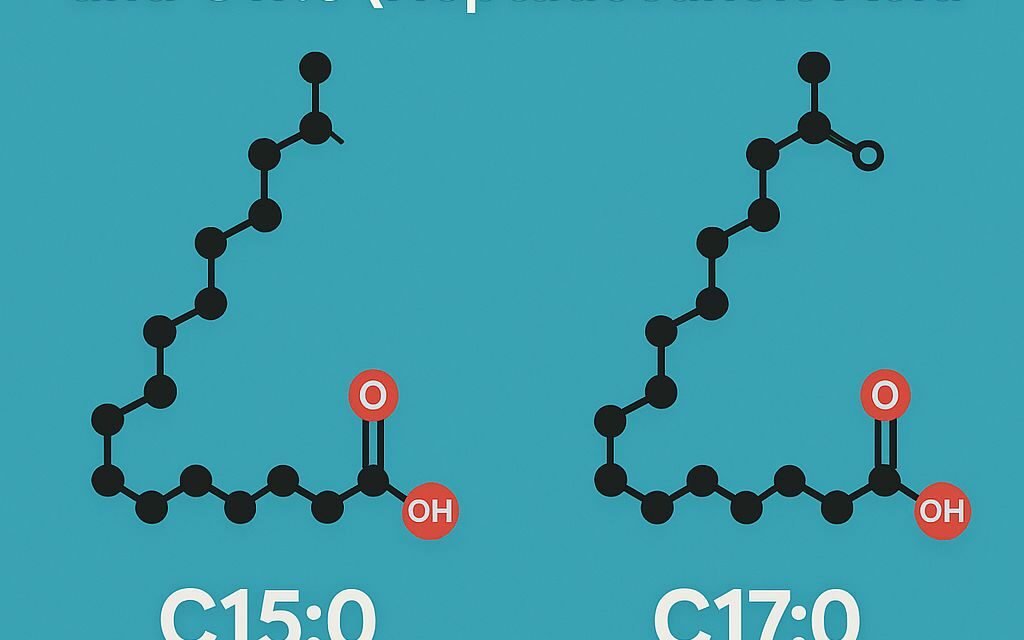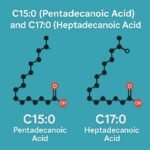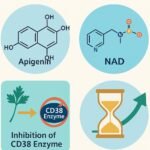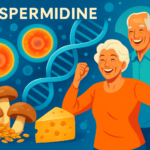Introduction to C15:0 and C17:0
For decades, saturated fats were labeled as dietary villains. But science is rewriting that story—especially for two rare, odd-chain saturated fatty acids: C15:0 (pentadecanoic acid) and C17:0 (heptadecanoic acid).
These molecules, naturally found in small amounts in grass-fed dairy, butter, and some fish, are now recognized as essential nutrients with powerful effects on cellular health, metabolic balance, and longevity.
What Are Odd-Chain Saturated Fatty Acids?
Most dietary fats have even carbon chains, like C16:0 (palmitic acid) or C18:0 (stearic acid).
However, odd-chain saturated fatty acids (OCSFAs)—like C15:0 and C17:0—have an odd number of carbon atoms, which gives them unique metabolic properties.
These fats serve as bioactive molecules, influencing cell membranes, mitochondrial function, and inflammation. Recent evidence suggests they may even act as essential nutrients, meaning the human body can’t make enough of them on its own.
How C15:0 and C17:0 Differ from Even-Chain Fats
While most saturated fats can raise LDL cholesterol, odd-chain fats behave differently.
Studies show that higher circulating levels of C15:0 and C17:0 are inversely associated with risks of heart disease, type 2 diabetes, and mortality.
They’re also more stable and less prone to oxidation than polyunsaturated fats, making them beneficial for cell membrane integrity—a key factor in healthy aging.
Historical View: From “Bad” Saturated Fats to Essential Nutrients :-
Why Science Misunderstood These Fats
For decades, all saturated fats were lumped together in nutrition research. This broad categorization ignored structural differences that make odd-chain fats unique. As a result, C15:0 and C17:0 were unfairly demonized, despite their protective effects.
Modern Research and Paradigm Shift
Recent lipidomics research has transformed our understanding. Studies from Harvard, National Institutes of Health (NIH), and Fatty15 researchers demonstrate that higher blood levels of these fatty acids correlate with better metabolic and cardiovascular health.
C15:0 (Pentadecanoic Acid): The Stability Fat
C15:0, also called pentadecanoic acid, plays a vital role in maintaining cellular stability—especially as we age.
Cell Membrane Stability and Aging
As we get older, our cell membranes become more fragile and prone to oxidative stress. C15:0 integrates into these membranes, strengthening their structure and reducing breakdown. This stabilization supports longer cell lifespan and resilience.
Anti-Inflammatory and Metabolic Benefits
C15:0 helps balance inflammation by modulating PPARα and PPARδ receptors, which regulate lipid metabolism, glucose utilization, and immune response. Clinical studies suggest this fatty acid helps reduce chronic inflammation and improve metabolic flexibility.
C15:0 and Mitochondrial Health
Mitochondria are the “powerhouses” of cells, and their decline accelerates aging. C15:0 enhances mitochondrial efficiency, supporting sustained energy and reducing cellular wear.
C17:0 (Heptadecanoic Acid): The Metabolic Protector
C17:0, or heptadecanoic acid, is another potent odd-chain fat with unique metabolic benefits.
Role in Insulin Sensitivity
Epidemiological data reveal that individuals with higher C17:0 levels have better insulin sensitivity and a lower risk of developing diabetes. This suggests that it enhances the body’s ability to utilize glucose efficiently.
C17:0 and Cardiovascular Protection
Unlike harmful trans fats, C17:0 correlates with lower triglycerides, reduced inflammation, and improved vascular function, promoting overall heart health.
C17:0 and Gut Microbiome Harmony
Emerging studies show that C17:0 supports a balanced gut microbiome, reducing endotoxin production and improving immune system regulation.
Scientific Evidence Supporting C15:0 and C17:0 :-
Human Epidemiological Studies
Long-term studies, such as those published in The American Journal of Clinical Nutrition, demonstrate that higher circulating levels of C15:0 and C17:0 are associated with lower mortality and reduced chronic disease risks.
Animal and Cellular Studies
Laboratory research confirms these fats improve cellular repair, mitochondrial function, and anti-inflammatory signaling pathways, providing biological plausibility to their health benefits.
Natural Sources of C15:0 and C17:0
While these beneficial fatty acids are present in trace amounts in most diets, they’re naturally concentrated in certain foods—particularly those derived from grass-fed animals and marine sources.
Grass-Fed Dairy and Meat
- Grass-fed milk, butter, and cheese contain the highest natural levels of C15:0 and C17:0.
- These compounds are synthesized in the digestive systems of ruminant animals like cows, goats, and sheep, then stored in their milk and fat.
- Compared to grain-fed dairy, grass-fed varieties contain up to three times more C15:0, making them a superior choice for boosting your intake naturally.
Examples of high-C15:0 and C17:0 foods:
| Food Source | Approximate Content (per 100g) | Notes |
| Grass-fed butter | 200–300 mg of C15:0 | Also rich in conjugated linoleic acid (CLA) |
| Whole milk (grass-fed) | 40–60 mg of C15:0 | Best consumed minimally processed |
| Cheese (raw/aged) | 150–200 mg of combined C15:0 and C17:0 | Excellent long-chain fat source |
| Grass-fed beef/lamb fat | 100–250 mg of C15:0 | Found primarily in the fat portion |
Marine and Plant-Based Alternatives
While plant sources are limited, certain marine foods—like salmon, sardines, and algae-fed fish—contain small but measurable amounts.
Plant-based eaters may obtain precursors through odd-chain propionate pathways in the gut, though conversion efficiency is low. For vegans, supplementation may be necessary.
Supplementation and Dosage :-
FA15™ and Pure C15:0 Supplements
Given the difficulty of obtaining sufficient C15:0 from diet alone, scientists have developed purified C15:0 formulations, such as FA15™ (found in the product fatty15®).
These contain pure, stable C15:0 in a vegan, sustainable form derived from microalgae. Studies suggest supplementation can help restore declining C15:0 levels, especially in adults over 40.
Safe Intake Levels and Considerations
- The optimal daily intake for health benefits is estimated around 100–200 mg per day.
- C15:0 has shown no significant toxicity or adverse effects even at higher doses in preclinical studies.
- It’s lipid-soluble, so consuming it with food enhances absorption.
If you’re on lipid-lowering medication or have metabolic disorders, consult your healthcare provider before starting supplements.
Potential Side Effects and Precautions
C15:0 and C17:0 are naturally occurring, bio-identical fatty acids, and adverse effects are rare. However, excessive consumption of total saturated fat may still affect cholesterol balance if the diet is unbalanced.
Moderation and diversity are key—focus on integrating these fats within a nutrient-rich, whole-food diet.
Possible mild side effects when starting supplementation include:
- Temporary digestive changes (minor bloating or gas)
- Adjustments in lipid metabolism (rare, usually self-correcting)
- Mild skin oiliness in sensitive individuals
Always choose lab-tested, third-party verified supplements to ensure purity and stability.
Comparing C15:0 and C17:0 to Omega-3 Fatty Acids
Both odd-chain saturated fats and omega-3 polyunsaturated fats play crucial roles in longevity—but in different, complementary ways.
| Aspect | C15:0 & C17:0 | Omega-3 (EPA/DHA) |
| Fat Type | Odd-chain saturated | Polyunsaturated |
| Primary Role | Cell membrane stability & anti-aging | Anti-inflammatory & neuroprotective |
| Key Benefits | Mitochondrial support, reduced frailty, balanced metabolism | Lower triglycerides, brain and heart health |
| Best Sources | Grass-fed dairy, meat, supplements | Fish, krill oil, algae |
| Synergy | Work together for optimal cell resilience | Enhances anti-inflammatory effects |
In short, while omega-3s calm inflammation, C15:0 and C17:0 fortify cells—a perfect balance for healthy aging.
Future Research Directions
The study of odd-chain fatty acids is one of the fastest-growing fields in nutritional biochemistry.
Emerging research focuses on:
- C15:0 as the first newly discovered essential fatty acid in decades
- C17:0’s role in brain health and neuroprotection
- Therapeutic potential in metabolic syndrome and age-related diseases
- Clinical trials assessing combined supplementation (C15:0 + omega-3)
Scientists believe that understanding these fats could reshape dietary guidelines and lead to next-generation anti-aging therapies.
FAQs About C15:0 and C17:0 Health Benefits
1. What exactly are C15:0 and C17:0?
They are odd-chain saturated fatty acids, found mainly in grass-fed dairy and meats, now recognized for promoting longevity, metabolic balance, and cell stability.
2. Are C15:0 and C17:0 the same as other saturated fats?
No. Unlike typical even-chain fats, these odd-chain fats are protective, not harmful. Studies show they reduce the risk of heart disease and diabetes.
3. Can I get enough from food alone?
Possibly, if you regularly consume grass-fed dairy, butter, or meats. However, most modern diets fall short, so supplementation may be beneficial.
4. Are these fats safe for everyone?
Yes—C15:0 and C17:0 are natural nutrients. Still, individuals with specific lipid disorders or dietary restrictions should consult a doctor before supplementing.
5. How soon do benefits appear after supplementation?
Early reports suggest improved energy, mood, and metabolic markers within 6–8 weeks of consistent intake.
6. Can vegans benefit from these fats?
Yes, through microalgae-derived C15:0 supplements, which provide a plant-based and cruelty-free option identical to naturally occurring forms.
Conclusion: Rediscovering the Good Fats for a Longer, Healthier Life :-
For too long, all saturated fats were painted with the same brush—but science has evolved.
Today, C15:0 (pentadecanoic acid) and C17:0 (heptadecanoic acid) stand out as nutritional powerhouses—restoring cell stability, improving metabolism, and potentially extending human healthspan.
Whether through grass-fed dairy or targeted supplementation, integrating these “good fats” into your daily life can help you build resilience from the inside out.
To live longer and stronger, the answer might just lie in embracing the right kind of fat—the kind your body truly needs.










